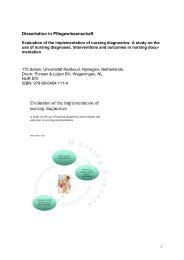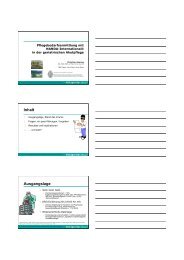pflegeinformatik - Pflege-PBS.ch
pflegeinformatik - Pflege-PBS.ch
pflegeinformatik - Pflege-PBS.ch
Sie wollen auch ein ePaper? Erhöhen Sie die Reichweite Ihrer Titel.
YUMPU macht aus Druck-PDFs automatisch weboptimierte ePaper, die Google liebt.
PFLEGEINFORMATIK<br />
Maria Müller Staub: <strong>Pflege</strong>klassifikationen im Verglei<strong>ch</strong><br />
Loomis ME, et al: Development of a classifi cation system for psy<strong>ch</strong>iatric/mental health nursing: individual<br />
response class, Ar<strong>ch</strong> Psy<strong>ch</strong>iatr Nurs 1:16, 1987.<br />
Kim MJ, McFarland G, McLane A, editors: Classifi cation of nursing diagnoses: proceedings of the fi fth conference,<br />
St Louis, 1984, Mosby. Contains new nursing diagnoses accepted in 1982 and papers on classifi cation<br />
development and issues, resear<strong>ch</strong>, implementation, and use in related areas of practice. First bylaws of the<br />
newly designated North American Nursing Diagnosis Association (NANDA).<br />
Hurley M, editor: Classifi cation of nursing diagnoses: proceedings of the sixth conference, St Louis, 1986,<br />
Mosby. Contains accepted nursing diagnoses, 1984. Includes papers on classifi cation, taxonomic structure,<br />
quality assurance, DRGs. implementation, and computerization. Includes resear<strong>ch</strong> papers on specifi c nursing<br />
diagnoses, their use in practice, diagnostic process, and resear<strong>ch</strong> methodology.<br />
McLane A, editor: Classifi cation of nursing diagnoses: proceedings of the seventh conference, St. Louis,<br />
1987, Mosby. Includes major papers presented, developments in diagnosis and taxonomy, resear<strong>ch</strong> paper<br />
abstracts, and current listing~ of nursing diagnoses, 1986.<br />
Carroll-Johnson R, editor: Classifi cation of nursing diagnoses: proceedings of the eighth conference, St Louis,<br />
1990, Mosby. Includes major papers presented, developments in diagnosis and taxonomy, resear<strong>ch</strong> papers<br />
and abstracts, and current listing of nursing diagnoses, 1988.<br />
Carroll-Johnson R, editor: Classifi cation of nursing diagnoses: proceedings of the ninth conference, Philadelphia,<br />
1992. Lippincott. Includes major papers presented, developments in diagnosis and taxonomy,<br />
resear<strong>ch</strong> papers and abstracts, and current listing of nursing diagnoses, 1990.<br />
Carroll-Johnson R, editor: Classifi cation of nursing diagnoses: proceedings of the tenth conference, Philadelphia,<br />
1993, Lippincott. Includes major papers, developments in diagnosis and taxonomy, resear<strong>ch</strong> papers<br />
and abstracts, and current listing of nursing diagnoses, 1993.<br />
Visiting Nurse Service of Omaha, Client management information system for community health nursing<br />
agencies, Washington, DC, 1986, US Department of Health and Human Services. Classifi cation of problems<br />
in community health nursing. There is an overlap with NANDA diagnostic categories.<br />
Anhang I:<br />
<strong>Pflege</strong>diagnose Beeinträ<strong>ch</strong>tigte körperli<strong>ch</strong>e Mobilität<br />
Beeinträ<strong>ch</strong>tigte körperli<strong>ch</strong>e Mobilität (Grad/Stufe angeben)<br />
Taxonomie 1 R Si<strong>ch</strong> bewegen (6.1.1.1/1973; R 1998)<br />
Taxonomie 2: Aktivität/Ruhe, Aktivität/Bewegung (00085/1973, R 1998)<br />
NANDA-Originalbezei<strong>ch</strong>nung: «Impaired Physical Mobility» (Thematis<strong>ch</strong>e Gliederung: Si<strong>ch</strong>erheit)<br />
Defi nition: Eine Eins<strong>ch</strong>ränkung der unabhängigen, zielgeri<strong>ch</strong>teten physis<strong>ch</strong>en Bewegung<br />
des Körpers oder einer oder mehrerer Extremitäten..<br />
Diagnostis<strong>ch</strong>er Hinweis der Übersetzergruppe: taxonomis<strong>ch</strong> ist diese Diagnose eine übergeordnete<br />
Kategorie, die genauere/detailliertere Diagnosen umfasst. Wenn die Ersteins<strong>ch</strong>ätzung<br />
zu dieser Diagnose führt, sind weitere Abklärungen nötig, um die spezifi s<strong>ch</strong>en<br />
Bedürfnisse des Patienten festszustellen und wenn mögli<strong>ch</strong> sollte eine genauere Diagnose<br />
gestellt werden (hier z.B.: Gefahr einer peripheren neurovaskulären Störung, Gefahr eines<br />
perioperativen Lagerungss<strong>ch</strong>adens, beeinträ<strong>ch</strong>tigte Bettmobilität, beeinträ<strong>ch</strong>tigte Transferfähigkeit,<br />
beeinträ<strong>ch</strong>tigte Rollstuhlmobilität).<br />
Mögli<strong>ch</strong>e ursä<strong>ch</strong>li<strong>ch</strong>e oder beeinfl ussende Faktoren<br />
• Sitzende Lebensweise, Inaktivität oder Immobilität; begrenzte kardiovaskuläre Ausdauer<br />
• Verminderte Muskelkraft, -kontrolle und/oder -masse; Gelenksteifi gkeit oder Kontraktur;<br />
verminderte Kno<strong>ch</strong>enfestigkeit und -stabilität<br />
• Aktivitätsintoleranz/verminderte Kraft und Ausdauer<br />
• S<strong>ch</strong>merz/Missbehagen<br />
• Neuromuskuläre/muskuloskeletale Beeinträ<strong>ch</strong>tigung<br />
• Wahrnehmungsstörung oder kognitive Beeinträ<strong>ch</strong>tigung; Entwicklungsverzögerung<br />
• Depressive Stimmung oder Angstgefühle<br />
• Teilweise oder generalisierte Mangelernährung; veränderter Zellstoffwe<strong>ch</strong>sel; Body Mass<br />
Index 75% über der altersgemäßen Norm<br />
• Fehlendes Wissen über die Bedeutung körperli<strong>ch</strong>er Bewegung, kulturelle Vorstellungen<br />
über altersentspre<strong>ch</strong>ende Bewegung; fehlende physis<strong>ch</strong>e oder soziale Unterstützung<br />
dur<strong>ch</strong> die Umgebung<br />
• Verordnete Bewegungseins<strong>ch</strong>ränkung; Medikamentenwirkung [z.B. Neuroleptika, Muskelrelaxanzien]<br />
• Widerwille, si<strong>ch</strong> freiwillig zu bewegen<br />
373 PRINTERNET 6/04






